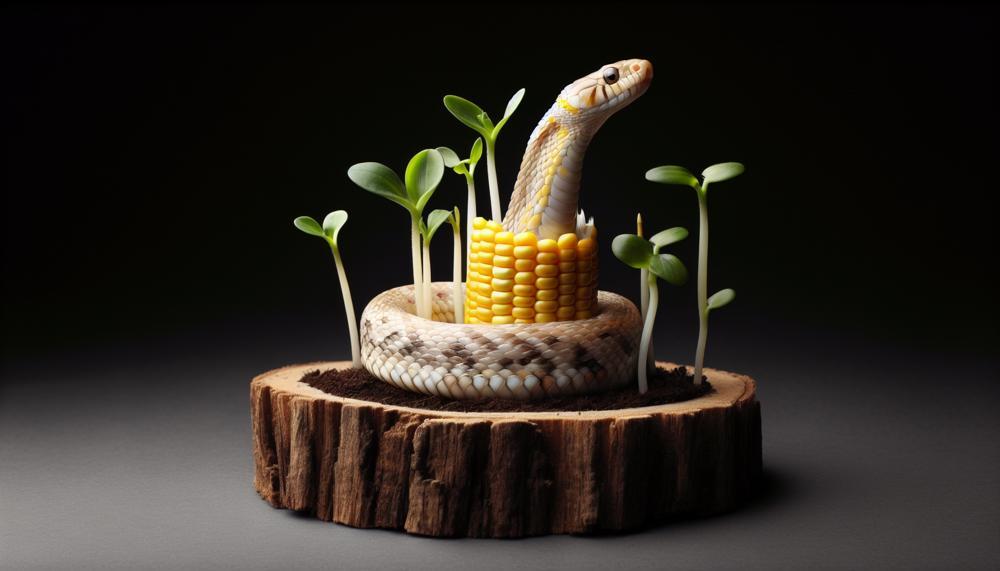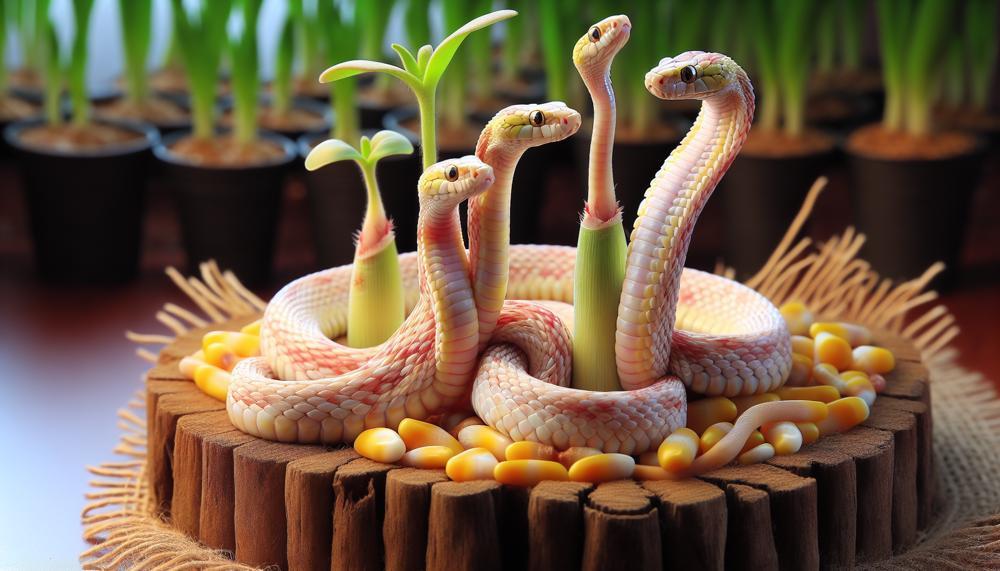Are you a reptile enthusiast? If so, then you’re probably familiar with the beloved corn snake. These captivating creatures have been gaining popularity in the pet trade due to their gentle demeanor and stunning colors. But did you know that besides being great pets, corn snakes also have an impressive growth rate?
Here are some key facts to bring you up to speed on the growth rate of these slithering beauties:
- Corn snakes can grow up to 5 feet long, making them one of the largest species in the Colubridae family.
- Their growth rate is remarkable, with hatchlings doubling in size within just one year.
- In optimal conditions, corn snakes can add up to 1 foot per year until they reach their full size.
- A diverse diet is crucial for their growth, as they need a variety of prey such as mice and rats.
- The environment also plays a crucial role in their growth rate, requiring proper heating and humidity levels.
With their swift development, it’s no surprise why corn snakes make fantastic long-term companions.
So if you’re considering adding one to your family, be prepared for some speedy growth and lots of affection from your new scaly friend.
Contents
- 1 Understanding Corn Snake Growth Rate: From Hatchling to Full Size
- 2 Factors Affecting How Fast Do Corn Snakes Grow: Genetics, Diet, and Environment
- 3 Deciphering the Corn Snake Growth Chart: What Can Affect The Growth?
- 4 The Impact of Captivity on Corn Snake Growth: Comparing Wild and Pet Corn Snakes
- 5 Female Corn Snakes vs. Male Corn Snakes: Differences in Size And Growth
- 6 How Large Do Corn Snakes Get When They Reach Full Size?
- 7 How Quickly Do Corn Snakes Reach Their Full Size, And What Affects Corn Snake Growth?
- 8 Conclusion
Understanding Corn Snake Growth Rate: From Hatchling to Full Size
Corn snakes are a popular choice and provide an excellent opportunity for studying growth dynamics. At birth, these snakes measure between 8 and 14 inches long and experience most of their growth within the first year. After that, they continue to grow gradually until they reach their full adult size.
Proper care and maintenance are vital for the healthy development and growth of corn snakes. A well-balanced diet with high protein content, optimal temperature and humidity levels, and a controlled environment can result in faster and more predictable growth rates in captivity compared to wild corn snakes.
When fully grown, male corn snakes tend to weigh more than females, but both reach an average length of around 60 inches or 5 feet by their second birthday. However, it is worth noting that each snake may have slightly different growth rates due to individual genetics and other factors.
Factors Affecting How Fast Do Corn Snakes Grow: Genetics, Diet, and Environment
The pace at which corn snakes grow is influenced by multiple factors, including genetics, diet, and environment. These three elements play a crucial role in determining the size and overall health of a corn snake.
| Genetics | Diet | Environment |
| The genetic makeup of a corn snake can significantly affect its growth rate. Some snakes may have a natural tendency to grow larger or smaller due to their genes. For example, female corn snakes are typically larger and heavier than males due to their reproductive abilities. Genetics can also impact the overall well-being and development of a snake, which in turn can affect its growth rate. | The diet of a corn snake is another crucial factor in its growth rate. A well-balanced diet that meets the snake’s nutritional requirements is essential for healthy growth. Hatchlings need more frequent meals than adults, and their diet should mainly consist of appropriately sized prey items like pinky mice. As they mature, their diet should gradually increase in size to meet their energy needs. | The environment in which a corn snake is kept can also influence its growth rate. The size of the enclosure and temperature are vital for the overall health and development of the snake. A larger habitat allows for more physical activity and muscle development, while appropriate temperature levels ensure proper digestion and metabolism. |
Moreover, providing opportunities for exercise, such as branches or other climbing structures, can also promote healthy growth and muscle development.
Deciphering the Corn Snake Growth Chart: What Can Affect The Growth?
The growth rate of a corn snake can be influenced by a multitude of factors, ranging from genetics and diet to temperature and health. Even the snake’s age can play a significant role in how quickly or slowly it grows, and these factors can have varying effects on its overall health and development.
It is crucial to have a thorough understanding of these factors and provide proper care to ensure the optimal growth and development of your corn snake.
- One of the most critical factors that affect the growth rate of a corn snake is genetics. Just like humans, snakes inherit certain traits from their parents, including size and growth potential. Therefore, it is essential to research the genetic history of your snake or obtain one from a reputable breeder to ensure it has the potential for healthy growth.
- Diet also plays a crucial role in a corn snake’s growth. A balanced and nutritious diet is essential for proper development, and it should include a variety of prey items such as rodents, birds, and even insects. However, overfeeding or underfeeding can severely impact the snake’s growth rate, leading to health issues.
- The temperature of the enclosure is another crucial factor that can influence a corn snake’s growth. These snakes require a specific temperature range for optimal growth, with cooler temperatures slowing down their metabolism and potentially causing stunted growth. On the other hand, higher temperatures can lead to faster metabolism and potentially result in rapid but unhealthy growth.
- The overall health of a corn snake also plays a significant role in its growth rate. Any underlying health issues, such as infections or parasites, can hinder its growth and development. Therefore, regular check-ups with a reptile-savvy veterinarian are crucial for maintaining your snake’s health and promoting proper growth.
- Lastly, age is another factor that can affect the growth rate of a corn snake. Just like humans, younger snakes tend to grow at a faster rate than older ones. However, this growth rate will eventually slow down as the snake reaches adulthood.
Understanding and taking into consideration these factors can help you provide the best care for your corn snake, ensuring its optimal growth and development.
The Impact of Captivity on Corn Snake Growth: Comparing Wild and Pet Corn Snakes
The growth rate of corn snakes in captivity can significantly differ from that of their wild counterparts due to various factors, including diet, temperature, and genetics. In captivity, corn snakes tend to grow faster and larger due to the controlled environment and consistent food supply.
- Diet is a crucial factor that impacts the growth rate of captive corn snakes. In the wild, these snakes mainly feed on rodents and small mammals, which may not always be readily available. However, in captivity, owners can provide a consistent and well-balanced diet for their pet snakes, leading to healthier and faster growth.
- Temperature also plays a significant role in the growth rate of corn snakes. In captivity, owners can maintain a stable and controlled temperature that is optimal for the snake’s growth. On the other hand, wild corn snakes may experience fluctuations in temperature, which can affect their metabolism and ultimately their growth rate.
- Genetics is another factor that influences the growth rate of corn snakes. As mentioned earlier, female corn snakes are typically larger than males, a trend seen in approximately 66% of snake species. Offspring are likely to inherit size tendencies from their parents, which can impact their growth rate in captivity.
However, it is crucial to note that while captive corn snakes may grow faster and larger, they also have longer lifespans compared to wild snakes. With proper care and nutrition, these pet snakes can reach lengths of 5-6 feet, making them one of the larger snake species kept as pets.
Additionally, stress levels can also affect the growth rate of captive corn snakes. In the wild, these snakes are constantly exposed to stressors such as predators or harsh environmental conditions.
In contrast, owners must provide a stress-free environment for their pet snake to thrive and reach its full potential.
Female Corn Snakes vs. Male Corn Snakes: Differences in Size And Growth
When it comes to size and growth, female corn snakes are often overshadowed by their male counterparts. While males tend to be longer, reaching up to 72 inches, females can still grow to be a respectable 60 inches in length.
However, this is not a hard and fast rule and individual snakes may vary in size regardless of their gender.
The growth rate of both male and female corn snakes can also vary depending on their environment and genetics. A healthy diet and consistent temperature are crucial for proper growth, but even then, individual snakes may have different rates of growth.
Some may develop faster or slower than others, so it’s important to monitor your snake’s growth closely and consult a veterinarian if you have any concerns.
How Large Do Corn Snakes Get When They Reach Full Size?
As corn snakes reach full maturity, their sizes can differ greatly due to various factors like genetics, diet, and living conditions. Most adult corn snakes reach a length of 3-5 feet, but some can even grow up to 6 feet. Interestingly, female corn snakes tend to be heavier and bulkier compared to males, but males can grow longer.
For a more precise estimate, below is a table showing the average size range for both male and female corn snakes at different stages of their life:
| Age | Average Male Size (in feet) | Average Female Size (in feet) |
| Hatchling | 8-12 inches | 8-12 inches |
| Juvenile (1-2 years) | 2-3 feet | 2-4 feet |
| Adult (2+ years) | 3-5 feet | 4-6 feet |
It’s important to keep in mind that these are just rough estimates and individual corn snakes may vary from this. As mentioned earlier, factors like diet and living conditions play a crucial role in a snake’s growth rate. Also, since corn snakes can live up to 20 years in captivity, they will continue to grow and develop throughout their lifespan.
How Quickly Do Corn Snakes Reach Their Full Size, And What Affects Corn Snake Growth?
Corn snake growth is greatly influenced by various environmental factors, including temperature, diet, humidity, and enclosure size. These snakes are ectothermic, meaning they rely on external heat sources to regulate their body temperature. In the wild, they hibernate during colder months, whereas in captivity, it is essential to provide a temperature gradient within the enclosure for proper thermoregulation. Inadequate temperatures can negatively impact digestion and lead to sluggishness, ultimately affecting the snake’s growth rate.
Aside from temperature, diet is another crucial factor in corn snake growth. In their natural habitat, these snakes primarily feed on rodents such as mice and rats. Therefore, it is crucial to mimic this diet in captivity by providing appropriately sized prey items. Juvenile corn snakes should be fed once every 5-7 days, while adults can be fed every 10-14 days. It is essential to monitor their body condition and adjust feeding frequency accordingly to maintain a healthy growth rate.
Other environmental factors such as humidity and enclosure size also play a significant role in the growth of corn snakes. Low humidity levels can cause dehydration, while high levels can lead to respiratory infections. A larger enclosure allows for more movement and exercise, promoting healthy growth.
| Environmental Factor | Impact on Growth Rate |
| Temperature | Affects digestion and overall health; excessively low temperatures cause sluggishness and difficulties digesting food |
| Diet | Affects nutrition intake and overall health; overfeeding can lead to obesity, while underfeeding can result in stunted growth |
| Humidity | Low levels cause dehydration, while high levels can result in respiratory infections |
| Enclosure Size | Allows for movement and exercise, promoting healthy growth |

To ensure the optimal growth of corn snakes, it is crucial to consider various environmental factors such as temperature, diet, humidity, and enclosure size. These factors greatly impact the snake’s health and growth rate, and as an expert on this topic, I highly recommend regularly monitoring and adjusting them as needed.
Also Read: Are Ball Pythons Constrictors?
Conclusion
In conclusion, the growth rate of corn snakes is truly remarkable and can be influenced by a variety of factors such as genetics, diet, and environment.
These captivating creatures can reach lengths of up to 5 feet in just two years, making them one of the largest species in the Colubridae family. With proper care and a well-balanced diet consisting of a variety of prey items, these snakes can add up to 1 foot per year until they reach their full size.
However, it’s important to note that their environment also plays a crucial role in their growth rate, requiring appropriate heating and humidity levels. As passionate reptile enthusiasts, we are drawn to the beauty and gentle nature of corn snakes.
But beyond their physical appearance lies an impressive growth rate that is affected by various factors. By providing optimal conditions for our scaly friends, we can ensure they reach their full potential and live long, healthy lives as our companions.






